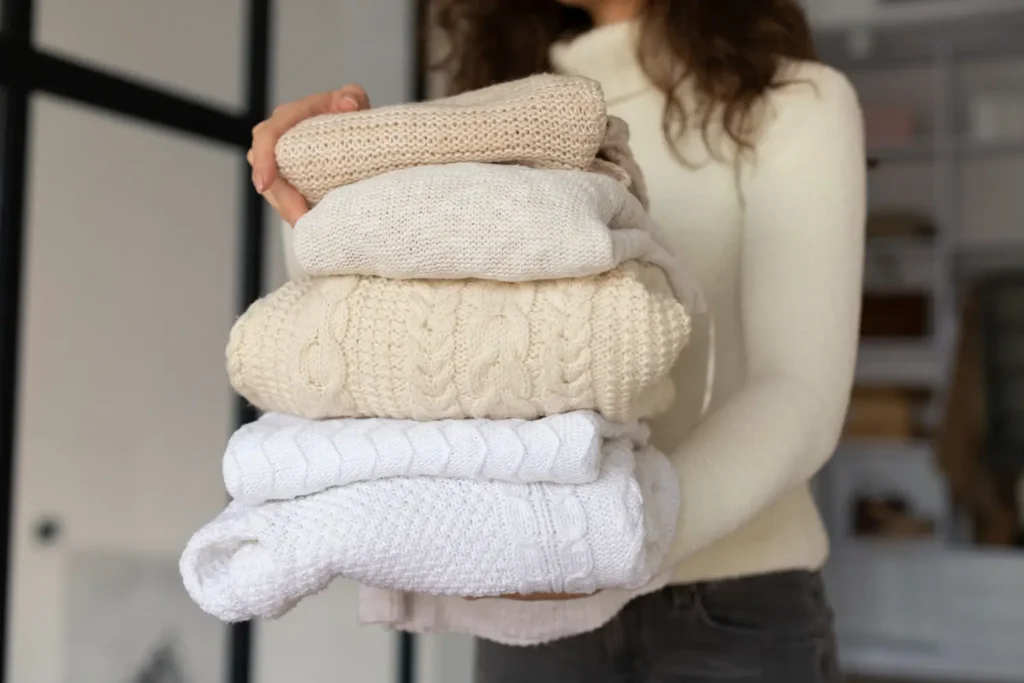Summary
- Some fabrics shrink after washing, and this can change the look and fit of a garment.
- If not considered during pattern making, shrinkage can lead to sizing issues and unhappy customers.
- Perfect your patterns, no matter the fabric challenges. Start your free Audaces360 trial today!
There’s nothing more frustrating for a pattern maker than seeing their work undone after it’s complete. Unfortunately, when working with fabrics that shrink, this is a common issue.
But you don’t have to wait until the garment is ready to find out that the fabric has shrinkage issues. There are techniques to prevent this, and technology can be your greatest ally.
In the next paragraphs, we will look at the most common fabrics prone to shrinking. We will also share tips on how to care for them. This will help you keep your work looking great.
Enjoy your reading!
Sumário
Why is it important to know fabrics that shrink?
Knowing which fabrics shrink when washed ensures accurate and consistent pattern making. It allows you to create garments that maintain their size and fit, even after multiple washes.
Mastering this knowledge also helps you make smarter choices, like accurately calculating the shrinkage margin. This helps you avoid waste and rework.
Moreover, understanding shrinking fabrics showcases your technical expertise and attention to detail.
Customers appreciate clothing items that retain their quality and comfort over time. And having a deep knowledge of the materials you work with is key to achieving this satisfaction.
Learn more: What is the best way to create a pattern of clothing?
What are the fabrics that shrink in the wash?
Some fabrics shrink more than others during the washing process. Knowing which materials have this tendency prevents surprises throughout the process.
Check out the main fabrics that shrink to consider when pattern making:
Cotton
Cotton is a natural fabric that tends to shrink, especially when washed in hot water.
Natural fibers like cotton are more sensitive to high heat. They also absorb more water than other materials, which can lead to shrinkage.
Rib knit fabric
Shrinkage in these fabrics is common. This happens because they often have elastic fibers, like elastane in rib knit fabrics.
Incorrect pattern making can affect the garment’s length and width, pull at the seams, and cause the fabric to twist.
Learn more: 4 mistakes you should avoid in clothing fit
Cashmere
Cashmere is a luxurious and delicate fabric that can shrink easily, especially when machine washed.
In addition to precise pattern making, it’s important to follow the care instructions on the garment’s care label. Brands should advise customers to handwash or use a gentle wash cycle to preserve the fabric’s quality.
Wool

Wool, being a natural fiber, can shrink when exposed to high temperatures and moisture.
To prevent shrinkage during washing, it’s crucial to handle the fabric with care during pattern making.
Before cutting your sample, soak the fabric in cold water for a few minutes. Avoid rubbing or twisting the wool to prevent distorting the fibers.
Linen
Linen is a durable natural fiber, but it tends to shrink after the first time of washing and drying.
Unlike other fabrics, manufacturers don’t chemically treat linen to stabilize its fibers. As a result, washing linen in hot water can cause it to lose its original shape.
When making patterns, remember to add a safety margin to the measurements. This is especially important for width, as it helps account for possible shrinkage after the first wash.
Learn more: 7 steps to implement auto fitting in your garment production
Knit fabric
Knits, especially those with cotton or other natural fibers, are highly susceptible to shrinkage. It’s essential to account for this during pattern making.
However, knits blended with polyester tend to shrink less. Polyester, being a synthetic fiber, has better resistance to deformation, shrinkage, and wrinkles.
When working with polyester-blended knits, keep in mind that fewer adjustments for shrinkage will be necessary.
Modal
Modal, despite being a more modern fiber, can still shrink since it is derived from cellulose, a natural material.
However, it is more resistant to shrinkage and loss of shape compared to cotton. When working with knits made from modal, you can expect a smaller percentage of shrinkage compared to the original size.
Silk
Silk, another natural fiber, is extremely delicate and can shrink easily. It is also prone to damage if not handled with care.
Always test the pattern before sending it to production. When cutting samples, be extra cautious with this type of fabric, as it is smooth and tends to slip on the cutting surface.
To make it easier, place a piece of cotton fabric underneath and use weights to secure it, rather than pins. Pins can leave permanent marks or holes in the silk.
Viscose
Viscose is a semi-synthetic fabric. It shrinks after washing, but not as much as 100% natural fabrics such as cotton, wool, and linen.
Shrinkage can reach up to 10%, but it’s important to confirm this with your supplier. Be sure to wash the fabric before cutting the sample to ensure the final piece is the correct size.
Stop letting slow processes hold back your pattern making and marking! Download our exclusive ebook and discover how to streamline your workflow.
How to identify fabrics that shrink?
Certain fabrics, like cotton, linen, and viscose, are more prone to shrinking when washed. They tend to change more than synthetic materials such as polyester.
The fabric’s composition is a key indicator of its shrinkage potential. However, it’s always best to consult suppliers to understand each material’s specific characteristics.
Fabric rolls usually come with labels detailing washing recommendations and shrinkage percentages. Use this information to make more precise decisions during pattern making.
What happens to clothing when it shrinks?
When fabric shrinks, the garment becomes smaller in both length and width, making it feel tighter.
Shrinkage also affects the fit. The piece may no longer sit properly on the body, causing unwanted folds or tight spots.
The appearance can change as well. Shrinking fabrics often lead to wrinkles, seam distortions, and twisting. T-shirts, for example, may develop a crooked hem.
Finally, shrinkage can shorten a fabric’s lifespan. Compressed fibers wear out faster, increasing the risk of tearing.
Learn more: 5 key cut lines every pattern maker should know
Is it possible to avoid pattern making mistakes with fabrics that shrink?
Yes, you can avoid mistakes when pattern making with fabrics that shrink. The key is understanding the raw material you’re working with.
Start by calculating the shrinkage margin and adding it to the pattern. This ensures the final piece maintains the correct size after washing.
It’s also essential to test the pattern before production. And don’t forget—always wash the fabric before cutting the sample.
Learn more: Master the use of industrial patterns in apparel production
How to predict fabric shrinkage during pattern making?

Pre-wash the fabric
Nobody wants surprises after cutting the fabric, right? To avoid this, pre-washing is essential. Wash the fabric under the same conditions the customer will use.
This helps you determine how much it shrinks. After washing, measure the fabric again to check for any changes.
Perform fabric relaxation
Relaxation is an important step. Lay the fabric flat and let it rest, allowing the fibers to settle. Afterward, check if the fabric has returned to its natural state or still shows signs of stretching.
Apply a shrinkage margin to the pattern
When creating the pattern, include a shrinkage margin based on the fabric type. This ensures that the final piece maintains its intended size, even after washing.
Use technologies that predict shrinkage
Advanced solutions for the fashion industry make this process easier. They automatically calculate and apply shrinkage margins in digital pattern making.
These technologies enhance accuracy and efficiency, preventing common errors when working with shrink-prone fabrics.
Learn more: Why simulate the 3D fit of garments before production?
Create patterns anticipating fabric shrinkage with Audaces technologies

Audaces Pattern
Audaces Pattern is an innovative software that simplifies pattern making. With this solution, you can create digital patterns quickly and accurately, boosting efficiency.
The system offers automatic adjustments, minimizing errors and reducing fabric waste. Additionally, its shrinkage tool further optimizes the process.
This feature allows you to apply positive values to increase the size of pieces that tend to shrink. On the other hand, you can add negative values to reduce the size of elastic fabrics.
Scaling is done directly on the original pattern base. With just a few clicks, you ensure accurate measurements and high-quality products.
Audaces Marker
Audaces Marker is the ultimate solution for creating perfect fabric cutting markers. We’ve harnessed cutting-edge technology to design it, enhancing the efficiency of the production process.
With this powerful ally, companies can lay out patterns in a way that reduces waste and makes the most of their raw materials.
It allows professionals to create markers more efficiently, saving both time and money.
Discover Audaces360 and unlock a world of possibilities for fashion design and production. Explore our comprehensive suite of solutions today!
FAQ
Knowing which fabrics shrink when washed ensures accurate and consistent pattern making. It allows you to create garments that maintain their size and fit, even after multiple washes.
The main fabrics that tend to shrink in the wash include cotton, linen, viscose, and wool.
The fabric’s composition is a key indicator of its shrinkage potential. Fabric rolls usually come with labels detailing washing recommendations and shrinkage percentages.










